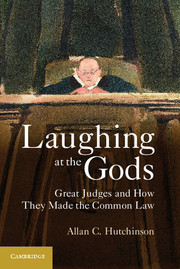1 - In Search of Great Judges
Playing by Their Own Rules
Published online by Cambridge University Press: 05 June 2012
Summary
When the current American chief justice, John Roberts, appeared before the Senate's Judicial Committee during his confirmation hearing, he confided that he did not have an “all-encompassing approach” to his judicial role or to constitutional interpretation particularly. He went on to say that “judges are like [baseball] umpires – umpires don't make the rules; they apply them.” He sealed this modest portrayal of judicial virtue by insisting that “judges have to have the humility to recognize that they operate within a system of precedent, shaped by other judges equally striving to live up to the judicial oath.” The not-so-implicit message of Roberts's credo was that being a good judge required restraint and forbearance; judges, even and perhaps especially Supreme Court ones, were not in the justice game in any expansive or direct way.
Although this humble depiction of judicial responsibility – “it's my job to call balls and strikes and not to pitch or bat” – will strike a reassuring chord with many, it fails to understand the history and nature of the judicial role in common law countries. That is, if the acknowledged pantheon of great judges is anything to go by, judges are much more than umpires. Any proposed list of candidates for a judicial hall of fame is far from being characterized by those judges’ self-understanding or by an essentially passive and restrained performance of their role. To paraphrase T.S. Eliot, if immature judges follow and mature judges lead, then great judges blaze entirely fresh trails.
- Type
- Chapter
- Information
- Laughing at the GodsGreat Judges and How They Made the Common Law, pp. 1 - 20Publisher: Cambridge University PressPrint publication year: 2012



